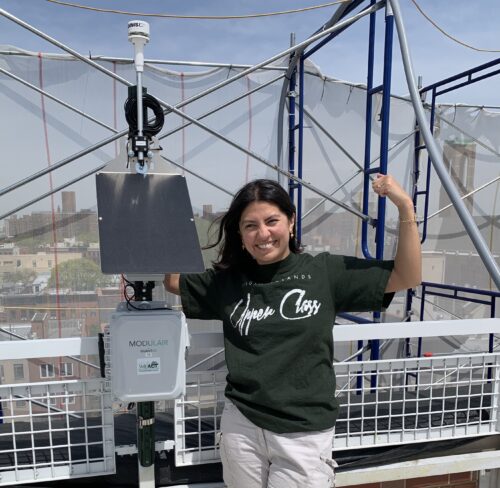In Northern Manhattan, poor air quality remains a persistent challenge rooted in decades of systemic inequity. While overall air quality in New York City has improved, low-income communities and communities of color continue to bear a disproportionate share of pollution and its health consequences. Northern Manhattan, for example, has some of the highest asthma rates in the country. This reflects broader research showing that people of color are exposed to more pollution, across all different types of pollution sources, which consistently results in greater adverse health outcomes.
Compounding these injustices, our communities have long been denied access to critical information about local pollution. Given the high cost equipment and technical expertise needed to monitor air quality, the closest monitors that produce publicly available data are located in Queens, miles away from the polluting facilities and heavy traffic corridors that directly impact Northern Manhattan. This lack of localized data is a clear example of epistemic injustice, where those most affected are systematically excluded from the knowledge and tools needed to understand and protect their own health.
LIVE: WE ACT’S COMMUNITY AIR MONITORING PROJECT
WE ACT’s Community Air Monitoring Project (CAMP) is our response to the environmental and epistemic injustices that have long denied our communities access to vital information about local pollution. CAMP is a community-driven initiative to democratize air quality data—ensuring that residents have the information, resources, and power to advocate for healthier environments.
In April 2025, we installed 18 high-quality air monitors on schools across Northern Manhattan. These QuantAQ sensors collect real-time data on seven EPA criteria pollutants, including particulate matter (PM₁, PM₂.₅, and PM₁₀) and gas-phase pollutants like carbon monoxide (CO), nitrogen oxides (NO, NO₂), and ozone (O₃).
Click here to view real-time air quality data from WE ACT’s CAMP monitors across Northern Manhattan.
PAST: COMMUNITY AIR MONITORING PROJECT
We first established a network of low-cost air monitors in October 2023, empowering WE ACT members to become community scientists by hosting monitors and conducting preliminary analyses of their own data. Over two years of collected data were then analyzed by a team of Capstone students from Columbia University’s Mailman School of Public Health.
A group of Capstone students at Columbia Mailman School of Public Health analyzed the over two years of data. You can explore our findings, including early insights into the potential impact of congestion pricing on air quality in Uptown communities, here!
WE ACT’s History of Improving Air Quality Northern Manhattan & Beyond
WE ACT for Environmental Justice has a long history of addressing air pollution in Northern Manhattan. In fact, it is part of our origin story.
WE ACT was founded in 1988 to address air pollution from the North River Sewage Treatment Plant. Despite the protest of our activist who would become known as the Sewage Seven, we had to sue the City to have the plant fixed because it wasn’t built up to code. Eventually we achieved a settlement, with $55 million set aside to fix the brand-new plant along with a $1.1 million environmental health fund for the community, that latter of which led to the formation of West Harlem Environmental Action, which we know today as WE ACT for Environmental Justice.
Then we took on the Metropolitan Transit Authority (MTA), which has sited all but one of its diesel bus depots in Manhattan in our community. A U.S. Environmental Protection Agency study at the time showed that the levels of air pollution in a number of Northern Manhattan neighborhoods exceeded proposed federal standards by as much as 200 percent.
In May 1997, we launched our Dirty Diesel campaign to raise awareness of the air pollution produced by the diesel buses in our community and the negative impact on the health or those who live here. The goal of this public awareness program was to convince the MTA to abide by the City’s idling laws, modify its bus depots to accommodate natural gas buses, and to only invest in clean-fuel buses.
Failing to get the desired action, we filed a Title VI Complaint with the U.S. Department of Transportation in November 2000, charging the MTA with violating the civil rights of Northern Manhattan residents. The MTA eventually saw the light, and years later it agreed to retrofit its depots and start investing in diesel retrofits and hybrids. As a result of our campaign, the MTA reduced its bus tailpipe emissions by 95 percent citywide.
